An Evaluation of Pumping Stations for Pressure Sewers System Made from Concrete Coils, Polymer Concrete, and High-Density Polyethylene (HDPE)
Abstract
:1. Introduction
- (a)
- to demonstrate the performance of centrifugal pumps operating simultaneously at rural, domestic sewage pumping stations;
- (b)
- to simulate pressurized sewage pumps;
- (c)
- to calculate a pressurized sewage system’s operating time;
- (d)
- to provide solutions to help prevent system leveling.
2. Materials and Methods
2.1. Study Object and Data for System Calibration
2.2. Modeling of the Operation of the Pressure Sewerage System
- Qpomp(t)—volume of wastewater pumped by the pump installed in the pumping station [dm/s].
- V(t)—volume of wastewater in the pumping station at time t [dm3],
- h(t)—change of wastewater in the pumping station at time t,
- d—internal diameter of the pumping station [m],
- v—velocity in the pressure pipe at the end of the system [m/s],
- V—active volume of wastewater contained between hmax–hmin,
- Q(t)—sewage inflow to the domestic pumping station at time t,
- hmax—maximum level of wastewater (level of activation of the pump) [m],
- hmin—minimum level of wastewater (pump off level) [m],
- hemer—emergency height above the pump switch-on level [m].
- Average annual wastewater production = 0.48 m3/d × 365 days = 175 m3/year;
- Power of drainage pump: 2.2 kW;
- Pump capacity: 1.6 dm3/s = 5.7 m3/h
- Annual pumping time: 175 m3/year / 5.7 m3/year = 31 h/year 31 h × 2.2 kW = 68 kWh
2.3. Input and Output Parameters of the Pressure Sewer System Model
- (a)
- lengths of individual sections of the main pipeline,
- (b)
- lengths of lateral sections,
- (c)
- ordinates of nodes,
- (d)
- ground ordinates of the pumping stations,
- (e)
- levels of activation and deactivation of the pumping station,
- (f)
- diameters of main pipelines,
- (g)
- diameters of side pipelines,
- (h)
- the diameter of the pumping station.
- (a)
- the operating point of the pump (intersection of pump characteristics and pipeline characteristics),
- (b)
- velocity in the various branches of the pipeline,
- (c)
- operation time of the pumps,
- (d)
- the number of pumps operating at the same time.
2.4. Description of the Research Model
2.5. Leveraging Model
- hst = HKZ—HPTT, [m]
- ζl1,l2—local loss per length, [-]
- λ—loss per length according to Colebrook and White, [-]
- Pa—atmospheric pressure, [Pa]
- Pk—pressure at the leveler knee, [Pa]
- HKZ—ordinate of the sewage water table in the pumping well, [m]
- HPTT—ordinate of the water table in the manhole, [m]
- ΣH—sum of hydraulic losses of the leveler, [m]
2.6. Field Tests and Statistical Measurements
3. Results
3.1. System Running Time
3.2. Simultaneous Co-Working
3.3. Determination of the Maximum Number of Centrifugal Pumps Working on a Common Pipeline
3.4. Research on the Operation of a Pumping Well in a Leveller System
3.5. Field Studies
4. Discussion
4.1. Sewage-Treatment Management
- -
- great freedom in routing sewer routes;
- -
- possibility of cooperation with other systems, such as gravity sewers or pressure systems;
- -
- elimination of infiltration and exfiltration phenomena through the need to use sealed pressure pipes;
- -
- potentially lower construction costs of pressure sewer systems in comparison with sanitary sewer systems due to shallower excavations [1.5 m] and smaller pipe diameters [from DN 63].
4.2. Reducing the Leveling Effect in Rural Sewage Systems
- -
- the daily sewage inflow to each pumping well was randomly drawn from a specific interval, but during the simulation studies after the drawing it was constant for the entire study period (30 days);
- -
- the hourly distribution of wastewater inflow for each day of the entire study period considered;
- -
- the density was assumed to be 1.1 g/cm3, viscosity 1 mm2/s, medium temperature 20 °C, suspended solid content 500 mg/dm3, according to Fyodorov’s tests.
4.3. Future Recommendation
5. Conclusions
Author Contributions
Funding
Institutional Review Board Statement
Informed Consent Statement
Data Availability Statement
Conflicts of Interest
Appendix A

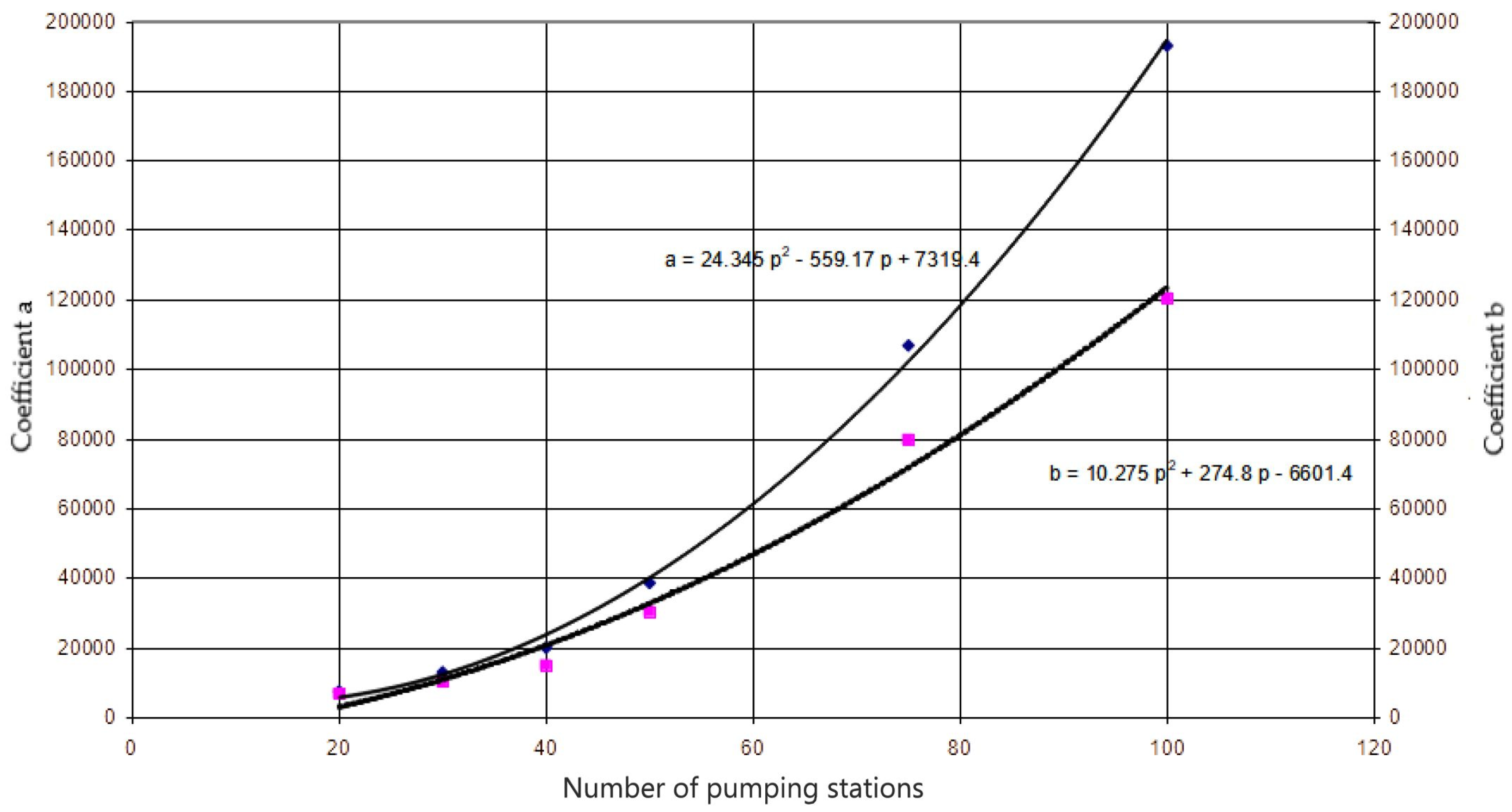
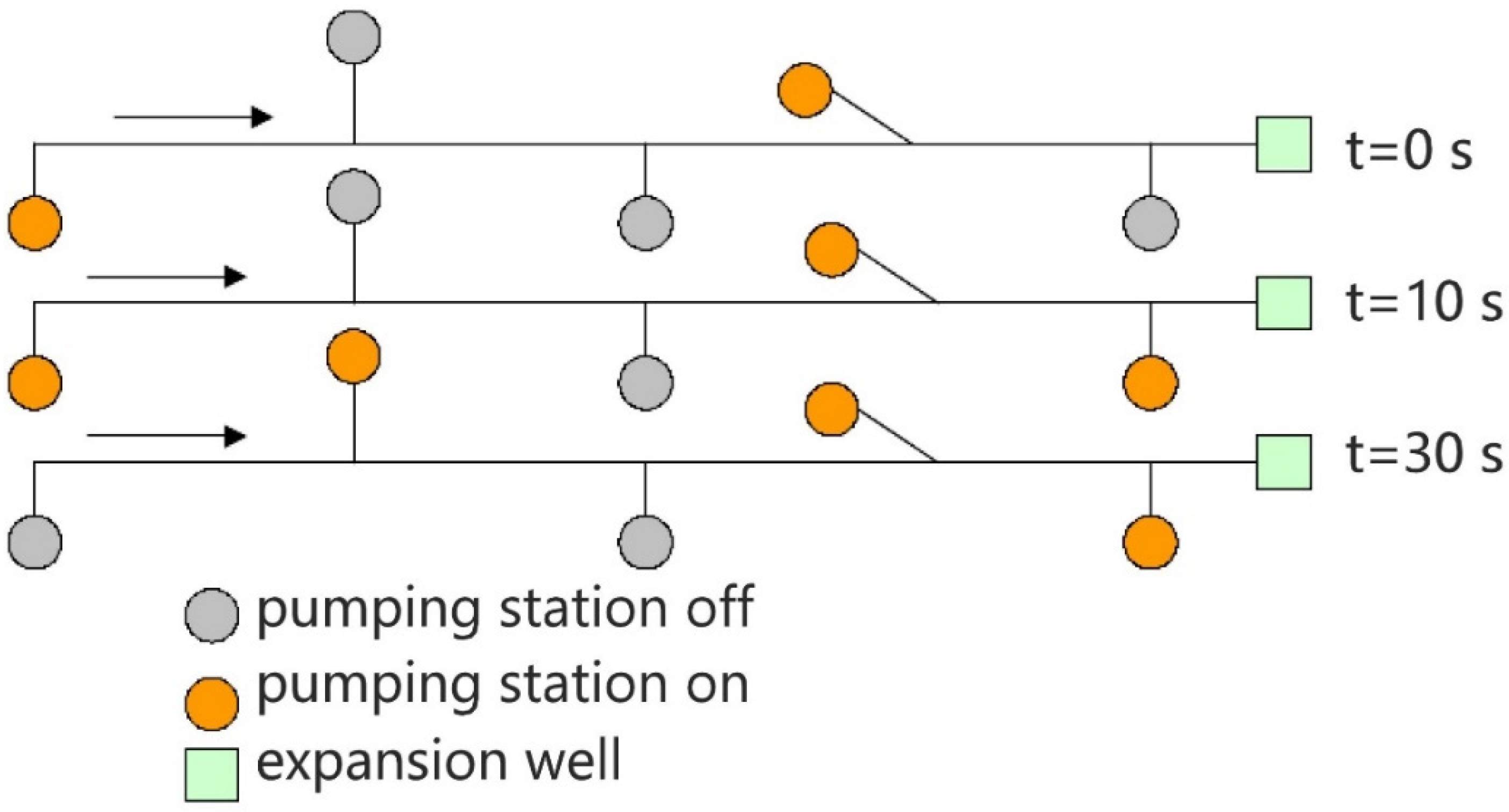
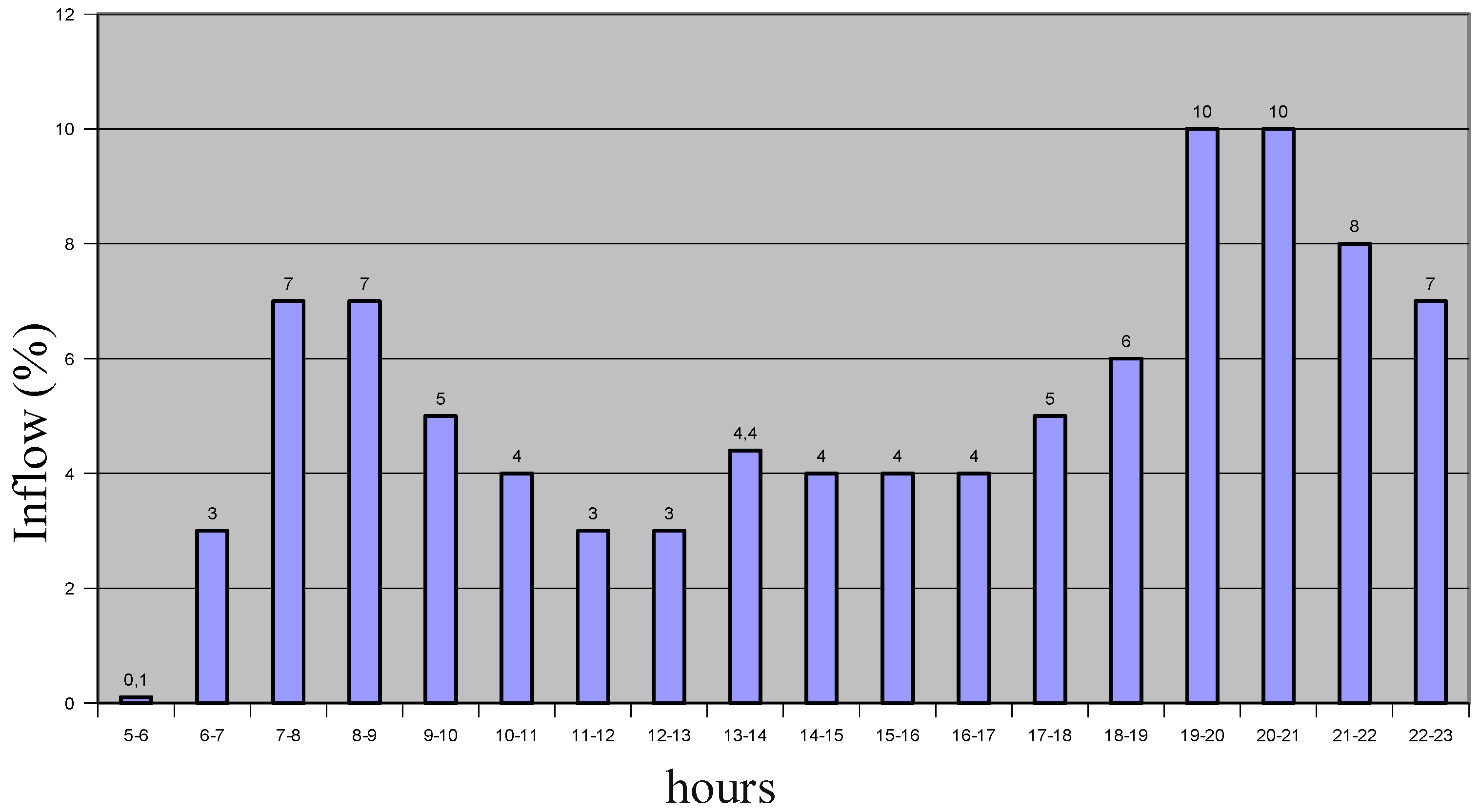
| Simulation Type | SIM1_10 | SIM1_20 | SIM1_30 | SIM1_40 | SIM1_50 | SIM1_750 | SIM1_100 |
|---|---|---|---|---|---|---|---|
| Sum [s] | 560 | 1860 | 3660 | 4910 | 15,160 | 43,546 | |
| Maximum [s] | No data | 100 | 140 | 130 | 180 | 170 | 270 |
| Average [s] | 56 | 60 | 64 | 65 | 66 | 79 | |
| Number of events | 10 | 31 | 57 | 76 | 228 | 544 | |
| Dail flow [dm3] | 499 | 477 | 463 | 462 | 458 | 468 | |
| Simulation type | SIM1_11 | SIM1_21 | SIM1_31 | SIM1_41 | SIM1_51 | SIM1_751 | SIM1_101 |
| Sum [s] | 510 | 1770 | 2080 | 6190 | 18,230 | 40,203 | |
| Maximum [s] | No data | 130 | 100 | 190 | 160 | 250 | 270 |
| Average [s] | 73 | 63 | 58 | 64 | 71 | 76 | |
| Number of events | 7 | 28 | 36 | 96 | 257 | 527 | |
| Dail flow [dm3] | 525 | 490 | 473 | 471 | 465 | 470 | |
| Simulation type | SIM1_12 | SIM1_22 | SIM1_32 | SIM1_42 | SIM1_52 | SIM1_752 | SIM1_102 |
| Sum [s] | 150 | 980 | 1530 | 3840 | 7540 | 15,650 | 50,403 |
| Maximum [s] | 90 | 100 | 150 | 170 | 380 | 200 | 280 |
| Average [s] | 75 | 65 | 61 | 59 | 67 | 67 | 82 |
| Number of events | 2 | 15 | 25 | 65 | 112 | 233 | 617 |
| Dail flow [dm3] | 545 | 508 | 479 | 476 | 473 | 476 | |
| Simulation type | SIM1_13 | SIM1_23 | SIM1_33 | SIM1_43 | SIM1_53 | SIM1_753 | SIM1_103 |
| Sum [s] | 180 | 890 | 1760 | 4300 | 5850 | 17,300 | 42,046 |
| Maximum [s] | 70 | 110 | 110 | 210 | 240 | 170 | 340 |
| Average [s] | 45 | 64 | 61 | 70 | 64 | 66 | 84 |
| Number of events | 4 | 14 | 29 | 61 | 92 | 261 | 501 |
| Dail flow [dm3] | 574 | 527 | 494 | 488 | 481 | 482 | |
| Simulation type | SIM1_14 | SIM1_24 | SIM1_34 | SIM1_44 | SIM1_54 | SIM1_754 | SIM1_104 |
| Sum [s] | 210 | 860 | 2440 | 4470 | 6800 | 22,010 | 44,489 |
| Maximum [s] | 70 | 120 | 150 | 190 | 260 | 230 | 210 |
| Average [s] | 53 | 66 | 61 | 67 | 67 | 73 | 76 |
| Number of events | 4 | 13 | 40 | 67 | 101 | 303 | 583 |
| Dail flow [dm3] | 601 | 547 | 507 | 500 | 488 | 486 | |
| Simulation type | SIM1_15 | SIM1_25 | SIM1_35 | SIM1_45 | SIM1_55 | SIM1_755 | SIM1_105 |
| Sum [s] | 400 | 1600 | 2570 | 3570 | 7260 | 20,960 | 45,774 |
| Maximum [s] | 110 | 160 | 180 | 150 | 150 | 300 | 260 |
| Average [s] | 57 | 73 | 73 | 57 | 60 | 70 | 85 |
| Number of events | 7 | 22 | 35 | 63 | 122 | 300 | 536 |
| Dail flow [dm3] | 621 | 559 | 521 | 509 | 495 | 492 | |
| Simulation type | SIM1_16 | SIM1_26 | SIM1_36 | SIM1_46 | SIM1_56 | SIM1_756 | SIM1_106 |
| Sum [s] | 1380 | 2830 | 5000 | 8850 | 22,420 | 43,589 | |
| Maximum [s] | No data | 130 | 100 | 170 | 270 | 250 | 130 |
| Average [s] | 63 | 63 | 60 | 65 | 73 | 81 | |
| Number of events | 23 | 45 | 84 | 136 | 306 | 540 | |
| Dail flow [dm3] | 644 | 575 | 534 | 519 | 502 | 498 | |
| Simulation type | SIM1_19 | SIM1_29 | SIM1_39 | SIM1_49 | SIM1_59 | SIM1_759 | SIM1_109 |
| Sum [s] | 1900 | 3520 | 5570 | 10,130 | 23,640 | 48,089 | |
| Maximum [s] | No data | 110 | 220 | 170 | 150 | 290 | 210 |
| Average [s] | 68 | 72 | 66 | 65 | 72 | 81 | |
| Number of events | 28 | 49 | 85 | 157 | 329 | 596 | |
| Dail flow [dm3] | 725 | 621 | 565 | 544 | 522 | 514 | |
| Simulation type | SIM1_10p | SIM1_20p | SIM1_30p | SIM1_40p | SIM1_50p | SIM1_75p | SIM1_100p |
| Sum [s] | 2380 | 4340 | 8440 | 15,860 | 31,050 | 118,594 | |
| Maximum [s] | No data | 190 | 130 | 150 | 220 | 280 | 330 |
| Average [s] | 79 | 64 | 64 | 69 | 75 | 94 | |
| Number of events | 30 | 68 | 131 | 229 | 412 | 1256 | |
| Dail flow [dm3] | 752 | 719 | 695 | 680 | 692 | 705 |
| Simulation Type | SIM2_10 | SIM2_20 | SIM2_30 | SIM2_40 | SIM2_50 | SIM2_750 | SIM2_100 |
|---|---|---|---|---|---|---|---|
| Sum [s] | 650 | 1120 | 5100 | 6180 | 17,480 | 39,817 | |
| Maximum [s] | No data | 170 | 180 | 320 | 240 | 410 | 430 |
| Average [s] | 130 | 124 | 138 | 131 | 144 | 157 | |
| Number of events | 5 | 9 | 37 | 47 | 121 | 253 | |
| Dail flow [dm3] | 499 | 477 | 463 | 462 | 458 | 468 | |
| Simulation type | SIM2_11 | SIM2_21 | SIM2_31 | SIM2_41 | SIM2_51 | SIM2_751 | SIM2_101 |
| Sum [s] | 160 | 450 | 1360 | 2740 | 7000 | 21,500 | 34,845 |
| Maximum [s] | 160 | 200 | 190 | 260 | 250 | 450 | 530 |
| Average [s] | 160 | 113 | 113 | 144 | 127 | 148 | 159 |
| Number of events | 1 | 4 | 11 | 18 | 54 | 144 | 214 |
| Dail flow [dm3] | 525 | 490 | 473 | 471 | 465 | 470 | |
| Simulation type | SIM2_12 | SIM2_22 | SIM2_32 | SIM2_42 | SIM2_52 | SIM2_752 | SIM2_102 |
| Sum [s] | 520 | 1210 | 1420 | 3720 | 6100 | 20,780 | 34,331 |
| Maximum [s] | 180 | 200 | 190 | 260 | 230 | 530 | 530 |
| Average [s] | 173 | 151 | 142 | 133 | 122 | 159 | 141 |
| Number of events | 3 | 7 | 9 | 27 | 49 | 130 | 240 |
| Dail flow [dm3] | 574 | 527 | 494 | 488 | 481 | 482 | |
| Simulation type | SIM2_13 | SIM2_23 | SIM2_33 | SIM2_43 | SIM2_53 | SIM2_753 | SIM2_103 |
| Sum [s] | 60 | 1100 | 2390 | 3460 | 7840 | 21,730 | 53,275 |
| Maximum [s] | 60 | 180 | 200 | 370 | 370 | 490 | 430 |
| Average [s] | 60 | 138 | 114 | 138 | 140 | 150 | 173 |
| Number of events | 1 | 7 | 20 | 24 | 55 | 144 | 304 |
| Dail flow [dm3] | 574 | 527 | 494 | 488 | 481 | 482 | |
| Simulation type | SIM2_14 | SIM2_24 | SIM2_34 | SIM2_44 | SIM2_54 | SIM2_754 | SIM2_104 |
| Sum [s] | 150 | 1060 | 2500 | 3420 | 7940 | 23,310 | 41,746 |
| Maximum [s] | 150 | 200 | 260 | 180 | 380 | 420 | 450 |
| Average [s] | 150 | 133 | 132 | 127 | 137 | 147 | 162 |
| Number of events | 1 | 7 | 18 | 26 | 57 | 158 | 253 |
| Dail flow [dm3] | 601 | 547 | 507 | 500 | 488 | 486 | |
| Simulation type | SIM2_15 | SIM2_25 | SIM2_35 | SIM2_45 | SIM2_55 | SIM2_755 | SIM2_105 |
| Sum [s] | 1200 | 3270 | 4090 | 8380 | 25,810 | 45,217 | |
| Maximum [s] | No data | 180 | 350 | 290 | 300 | 560 | 610 |
| Average [s] | 109 | 142 | 128 | 131 | 155 | 170 | |
| Number of events | 10 | 22 | 31 | 63 | 166 | 261 | |
| Dail flow [dm3] | 621 | 559 | 521 | 509 | 495 | 492 | |
| Simulation type | SIM2_16 | SIM2_26 | SIM2_36 | SIM2_46 | SIM2_56 | SIM2_756 | SIM2_106 |
| Sum [s] | 500 | 3010 | 3710 | 11,030 | 24,050 | 57,732 | |
| Maximum [s] | No data | 160 | 270 | 190 | 250 | 400 | 630 |
| Average [s] | 160 | 151 | 112 | 140 | 146 | 185 | |
| Number of events | 4 | 19 | 32 | 78 | 164 | 309 | |
| Dail flow [dm3] | 644 | 575 | 534 | 519 | 502 | 498 | |
| Simulation type | SIM2_19 | SIM2_29 | SIM2_39 | SIM2_49 | SIM2_59 | SIM2_759 | SIM2_109 |
| Sum [s] | 1820 | 4140 | 5940 | 10,940 | 26,400 | 49,503 | |
| Maximum [s] | No data | 230 | 230 | 270 | 310 | 380 | 530 |
| Average [s] | 121 | 134 | 145 | 146 | 150 | 178 | |
| Number of events | 15 | 31 | 41 | 75 | 176 | 279 | |
| Dail flow [dm3] | 725 | 621 | 565 | 544 | 522 | 514 | |
| Simulation type | SIM2_10p | SIM2_20p | SIM2_30p | SIM2_40p | SIM2_50p | SIM2_75p | SIM2_100p |
| Sum [s] | 870 | 1870 | 6050 | 11,320 | 18,550 | 53,300 | 119,108 |
| Maximum [s] | 150 | 290 | 250 | 290 | 480 | 600 | 770 |
| Average [s] | 109 | 141 | 138 | 138 | 153 | 165 | 185 |
| Number of events | 7 | 13 | 43 | 81 | 120 | 324 | 639 |
| Dail flow [dm3] | 752 | 719 | 695 | 680 | 692 | 705 |
References
- Sadegh Ali, M.R.; Zare, A.; Pournouri, M. Investigating and identifying the effects of rural wastewater in Dena protected area and presenting an environmental management pattern. Anthropog. Pollut. 2021, 5, 49–61. [Google Scholar]
- Obradović, D.; Šperac, M.; Marenjak, S. Maintenance issues of the pressure sewer system. Environ. Eng.-Inženjerstvo Okoliša 2019, 6, 40–48. [Google Scholar] [CrossRef] [Green Version]
- Cong, Z.X.; Shao, X.T.; Liu, S.Y.; Pei, W.; Wang, D.G. Wastewater analysis reveals urban, suburban, and rural spatial patterns of illicit drug use in Dalian, China. Environ. Sci. Pollut. Res. 2021, 28, 25503–25513. [Google Scholar] [CrossRef]
- Vigneswaran, S. Pressure filtration. In Water, Wastewater, and Sludge Filtration; CRC Press: Boca Raton, FL, USA, 2020; pp. 225–236. [Google Scholar]
- McCullough, P.; McDermott, R.A. Comparison of the Operational Energy Demand of Both Low Pressure and pressure Collection Systems. J. Water Resour. Prot. 2020, 12, 729. [Google Scholar] [CrossRef]
- Hamzaoui, A.; Hidouri, K.; Chaouachi, B. Comparative study of the performance of a locally manufactured membrane and the commercial one in pressure membrane distillation of brackish water. Desalin. Water Treat. 2022, 247, 10–16. [Google Scholar] [CrossRef]
- Bo, Y.; Wen, W. Treatment and technology of domestic sewage for improvement of rural environment in China. J. King Saud Univ. Sci. 2022, 34, 102181. [Google Scholar] [CrossRef]
- Liu, Z.; Huang, J.; Yao, Y.; Wang, M.; Li, A. Effect of Pretreatment by Freeze pressure Drying on Solid-State Anaerobic Digestion of Corn Straw. Fermentation 2022, 8, 259. [Google Scholar] [CrossRef]
- Hu, M.; Xiao, J.; Fan, B.; Sun, W.; Zhu, S. Constructing and selecting optimal sustainable sanitation system based on expanded structured decision-making for global sanitation and resources crisis. J. Clean. Prod. 2021, 318, 128598. [Google Scholar] [CrossRef]
- Malila, R.; Lehtoranta, S.; Viskari, E.L. The role of source separation in nutrient recovery–comparison of alternative wastewater treatment systems. J. Clean. Prod. 2019, 219, 350–358. [Google Scholar] [CrossRef]
- Wu, Y.; Song, S.; Chen, X.; Shi, Y.; Cui, H.; Liu, Y.; Yang, S. Source-specific ecological risks and critical source identification of PPCPs in surface water: Comparing urban and rural areas. Sci. Total Environ. 2023, 854, 158792. [Google Scholar] [CrossRef]
- Nalle, V.I.W.; Syaputri, M.D.; Haryono, P.F. Issues in Acceleration of Establishment of Domestic Wastewater Regulation in Indonesia. Mediterr. J. Soc. Sci. 2019, 10, 84–93. [Google Scholar] [CrossRef]
- Zawartka, P.; Burchart-Korol, D.; Blaut, A. Model of carbon footprint Assessment for the Life cycle of the System of Wastewater collection, transport and treatment. Sci. Rep. 2020, 10, 5799. [Google Scholar] [CrossRef] [PubMed] [Green Version]
- Huang, Y.; Li, P.; Li, H.; Zhang, B.; He, Y. To centralize or to decentralize? A systematic framework for optimizing rural wastewater treatment planning. J. Environ. Manag. 2021, 300, 113673. [Google Scholar] [CrossRef] [PubMed]
- Verma, S.K.; Singhal, P.; Chauhan, D.S. A synergistic evaluation on application of solar-thermal energy in water purification: Current scenario and future prospects. Energy Convers. Manag. 2019, 180, 372–390. [Google Scholar] [CrossRef]
- Brzusek, A.; Widomski, M.K.; Musz-Pomorska, A. Socio-Economic Aspects of Centralized Wastewater System for Rural Settlement under Conditions of Eastern Poland. Water 2022, 14, 1667. [Google Scholar] [CrossRef]
- Xu, M.; Zhang, Y.; Li, Y.; Lv, M.; Zhu, S.; Qian, T.; Fan, B. Energy recovery potential in coupling of sanitation and agriculture: Techno-economic analysis on resource-oriented sanitation. Waste Manag. 2021, 126, 141–151. [Google Scholar] [CrossRef] [PubMed]
- Niu, R.; Du, J.; Kong, X. Simulation study of membrane distillation regenerator based on reduced pressure air gap. J. Build. Eng. 2022, 62, 105273. [Google Scholar] [CrossRef]
- Gao, M.; Guo, B.; Zhang, L.; Zhang, Y.; Liu, Y. Microbial community dynamics in anaerobic digesters treating conventional and pressure toilet flushed blackwater. Water Res. 2019, 160, 249–258. [Google Scholar] [CrossRef]
- Li, Q.; Charlton, A.J.; Omar, A.; Dang, B.; Le-Clech, P.; Scott, J.; Taylor, R.A. A novel concentrated solar membrane-distillation for water purification in a building integrated design. Desalination 2022, 535, 115828. [Google Scholar] [CrossRef]
- O’Rourke, C.E.; Subedi, B. Occurrence and mass loading of synthetic opioids, synthetic cathinones, and synthetic cannabinoids in wastewater treatment plants in four US communities. Environ. Sci. Technol. 2020, 54, 6661–6670. [Google Scholar] [CrossRef]
- Beckinghausen, A.; Odlare, M.; Thorin, E.; Schwede, S. From removal to recovery: An evaluation of nitrogen recovery techniques from wastewater. Appl. Energy 2020, 263, 114616. [Google Scholar] [CrossRef]
- Nawrot, T.; Matz, R.; Błażejewski, R.; Spychała, M. A case study of a small diameter gravity sewerage system in Zolkiewka Commune, Poland. Water 2018, 10, 1358. [Google Scholar] [CrossRef] [Green Version]
- Li, W.; Zheng, T.; Ma, Y.; Liu, J. Analysis of suitable private-secondary-main sewer diameters in rural areas based on cost model and hydraulic calculation. J. Environ. Manag. 2021, 281, 111925. [Google Scholar] [CrossRef] [PubMed]
- Attea, T.A.E. Treatment of Concentrated Black-Water and Kitchen Organic-Wastes in Accumulation System.(Dept. C). Mansoura Eng. J. 2020, 31, 69–80. [Google Scholar] [CrossRef]
- Manderso, T.M. Overview of existing wastewater management system in case of Debre Markos Town, Ethiopia. Eng. Math. 2018, 2, 107. [Google Scholar]
- Min, H.; Hu, D.; Wang, H.; Zhao, Y.; Cui, Y.; Luo, K.; Zhang, L.; Liu, W.; Zhang, C.; Liu, Y.; et al. Efficient and facile integrated biological-electrocatalytic process for treating highly concentrated toilet wastewater. Chem. Eng. J. 2021, 403, 126321. [Google Scholar] [CrossRef]
- Ren, Q.; Chen, X.; Yumminaga, Y.; Wang, N.; Yan, W.; Li, Y.; Liu, L.; Shi, J. Effect of operating conditions on the performance of multichannel ceramic ultrafiltration membranes for cattle wastewater treatment. J. Water Process Eng. 2021, 41, 102102. [Google Scholar] [CrossRef]
- Burchart-Korol, D.; Zawartka, P. Environmental life cycle assessment of septic tanks in urban wastewater system: A case study for Poland. Arch. Environ. Prot. 2019, 45, 68–77. [Google Scholar]
- Janssen, A.; Pinedo, B.; Igartua, A.; Liiskmann, G.; Sexton, L. Study on friction and wear reducing surface micro-structures for a positive displacement pump handling highly abrasive shale oil. Tribol. Int. 2017, 107, 1–9. [Google Scholar] [CrossRef]
- Ravichandran, M.K.; Yoganathan, S.; Philip, L. Removal and risk assessment of pharmaceuticals and personal care products in a decentralized greywater treatment system serving an Indian rural community. J. Environ. Chem. Eng. 2021, 9, 106832. [Google Scholar] [CrossRef]
- Mohr, M.; Beckett, M.; Schließmann, U.; Erlbeck, R.; Trosse, R. pressure sewerage systems–a solution for fast growing cities in developing countries? Water Pract. Technol. 2018, 13, 157–163. [Google Scholar] [CrossRef]
- Cheng, F.; Dai, Z.; Shen, S.; Wang, S.; Lu, X. Characteristics of rural domestic wastewater with source separation. Water Sci. Technol. 2021, 83, 233–246. [Google Scholar] [CrossRef] [PubMed]
- Stefanakis, A.I. Constructed wetlands for sustainable wastewater treatment in hot and arid climates: Opportunities, challenges and case studies in the Middle East. Water 2020, 12, 1665. [Google Scholar] [CrossRef]
- Pathak, A.K.; Tyagi, V.V.; Anand, S.; Pandey, A.K.; Kothari, R. Advancement in solar still integration with phase change materials-based TES systems and nanofluid for water and wastewater treatment applications. J. Therm. Anal. Calorim. 2022, 147, 9181–9227. [Google Scholar] [CrossRef]
- Ravina, M.; Galletta, S.; Dagbetin, A.; Kamaleldin, O.A.H.; Mng’Ombe, M.; Mnyenyembe, L.; Shanko, A.; Zanetti, M. Urban Wastewater Treatment in African Countries: Evidence from the Hydroaid Initiative. Sustainability 2021, 13, 12828. [Google Scholar] [CrossRef]
- Xu, J.; Zhao, C.; Wang, F.; Yang, G. Industrial decarbonisation oriented distributed renewable generation towards wastewater treatment sector: Case from the Yangtze River Delta region in China. Energy 2022, 256, 124562. [Google Scholar] [CrossRef]
- Giang, N.T.H.; Huong, L.T.T.; Yabe, M.; Thang, N.T.; Hieu, V.N.; Son, C.T. Recycling Wastewater in Intensive Swine Farms: Selected Case Studies in Vietnam. J. Fac. Agric. Kyushu Univ. 2021, 66, 115–121. [Google Scholar] [CrossRef]
- Kosek, K.; Luczkiewicz, A.; Fudala-Książek, S.; Jankowska, K.; Szopińska, M.; Svahn, O.; Tränckner, J.; Kaiser, A.; Langas, V.; Björklund, E. Implementation of advanced micropollutants removal technologies in wastewater treatment plants (WWTPs)-Examples and challenges based on selected EU countries. Environ. Sci. Policy 2020, 112, 213–226. [Google Scholar] [CrossRef]
- Zhang, C.; Yi, X.; Chen, C.; Tian, D.; Liu, H.; Xie, L.; Zhu, X.; Huang, M.; Ying, G.-G. Contamination of neonicotinoid insecticides in soil-water-sediment systems of the urban and rural areas in a rapidly developing region: Guangzhou, South China. Environ. Int. 2020, 139, 105719. [Google Scholar] [CrossRef]
- Odirile, P.T.; Thukwi, I.; Dintwa, O.; Mbongwe, B. Faecal Sludge Management in Botswana: A Review of Current Practices and Policies Using the Case of Gaborone Low Income Areas. J. Environ. Prot. 2018, 9, 122. [Google Scholar] [CrossRef] [Green Version]
- Elkhatib, D.; Oyanedel-Craver, V. A critical review of extraction and identification methods of microplastics in wastewater and drinking water. Environ. Sci. Technol. 2020, 54, 7037–7049. [Google Scholar] [CrossRef] [PubMed]
- Oszczapińska, K. Materials and Prices of Sewage and Water Systems in Poland. J. Ecol. Eng. 2020, 21, 34–39. [Google Scholar] [CrossRef]
- Salem, H.A.; Gemail, K.S.; Nosair, A.M. A multidisciplinary approach for delineating wastewater flow paths in shallow groundwater aquifers: A case study in the southeastern part of the Nile Delta, Egypt. J. Contam. Hydrol. 2021, 236, 103701. [Google Scholar] [CrossRef] [PubMed]
- Ramos, E.; Padilla-Reyes, D.; Mora, A.; Barrios-Piña, H.; Kant, S.; Mahlknecht, J. Assessment of Artificial Sweeteners as Wastewater Co-Tracers in an Urban Groundwater System of Mexico (Monterrey Metropolitan Area). Water 2022, 14, 3210. [Google Scholar] [CrossRef]
- Zapasa, A.; Musz-Pomorska, A.; Gołębiowska, J.; Widomski, M.K. Financial, environmental and social sustainability of rural sanitary wastewater system: Case study. Appl. Water Sci. 2022, 12, 277. [Google Scholar] [CrossRef]
- Xu, M.; Zhu, S.; Zhang, Y.; Wang, H.; Fan, B. Spatial-temporal economic analysis of modern sustainable sanitation in rural China: Resource-oriented system. J. Clean. Prod. 2019, 233, 340–347. [Google Scholar] [CrossRef]
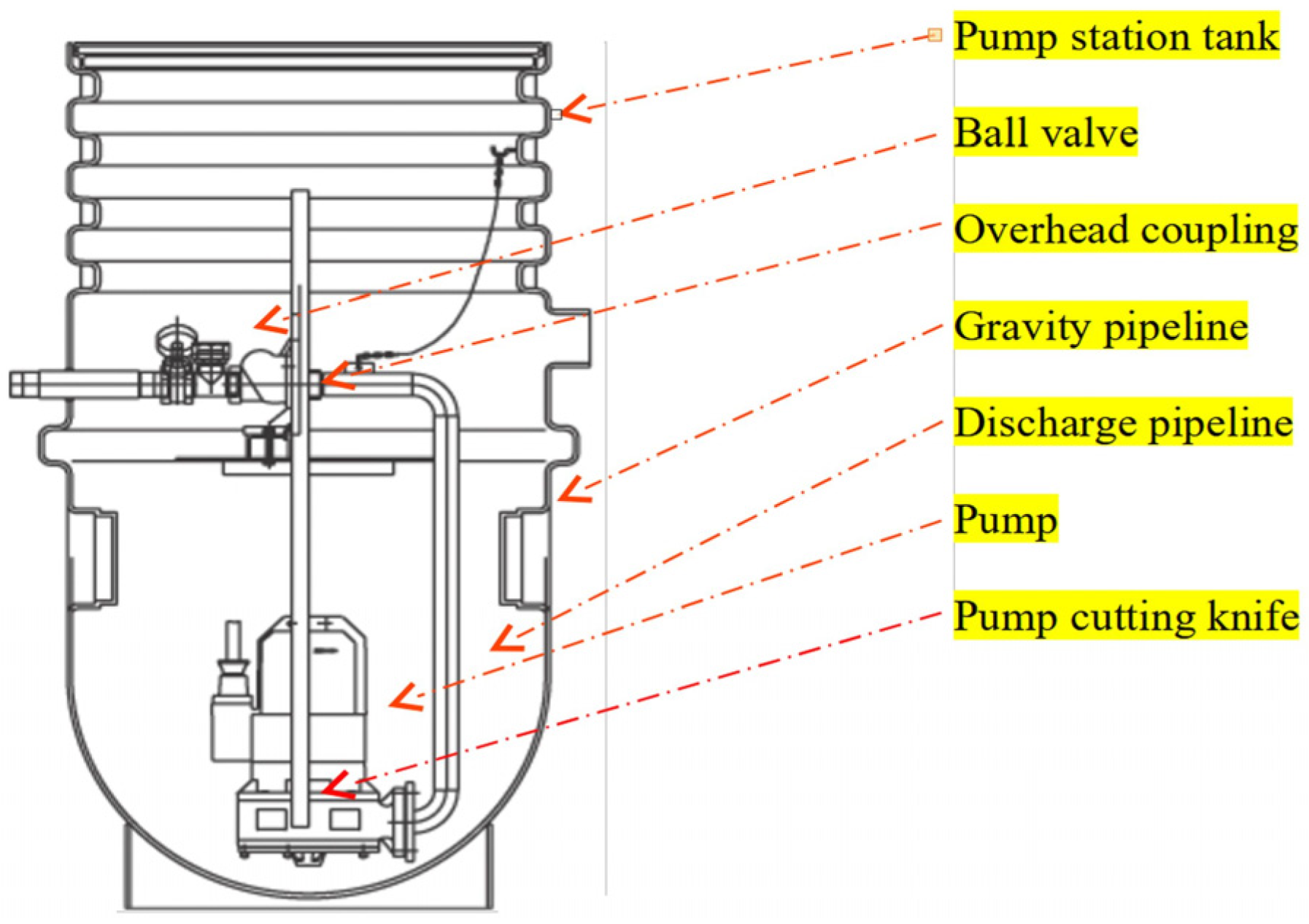
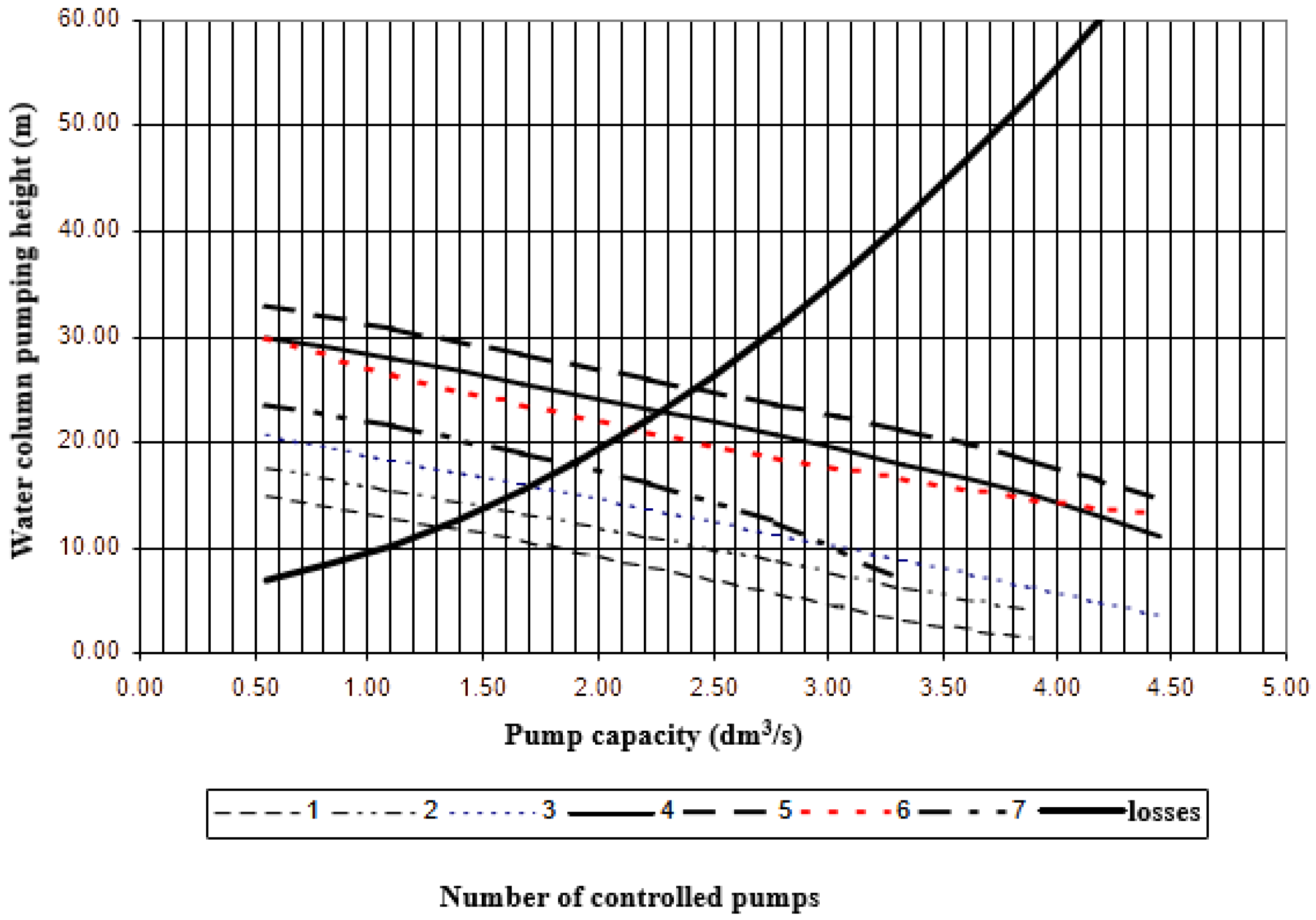
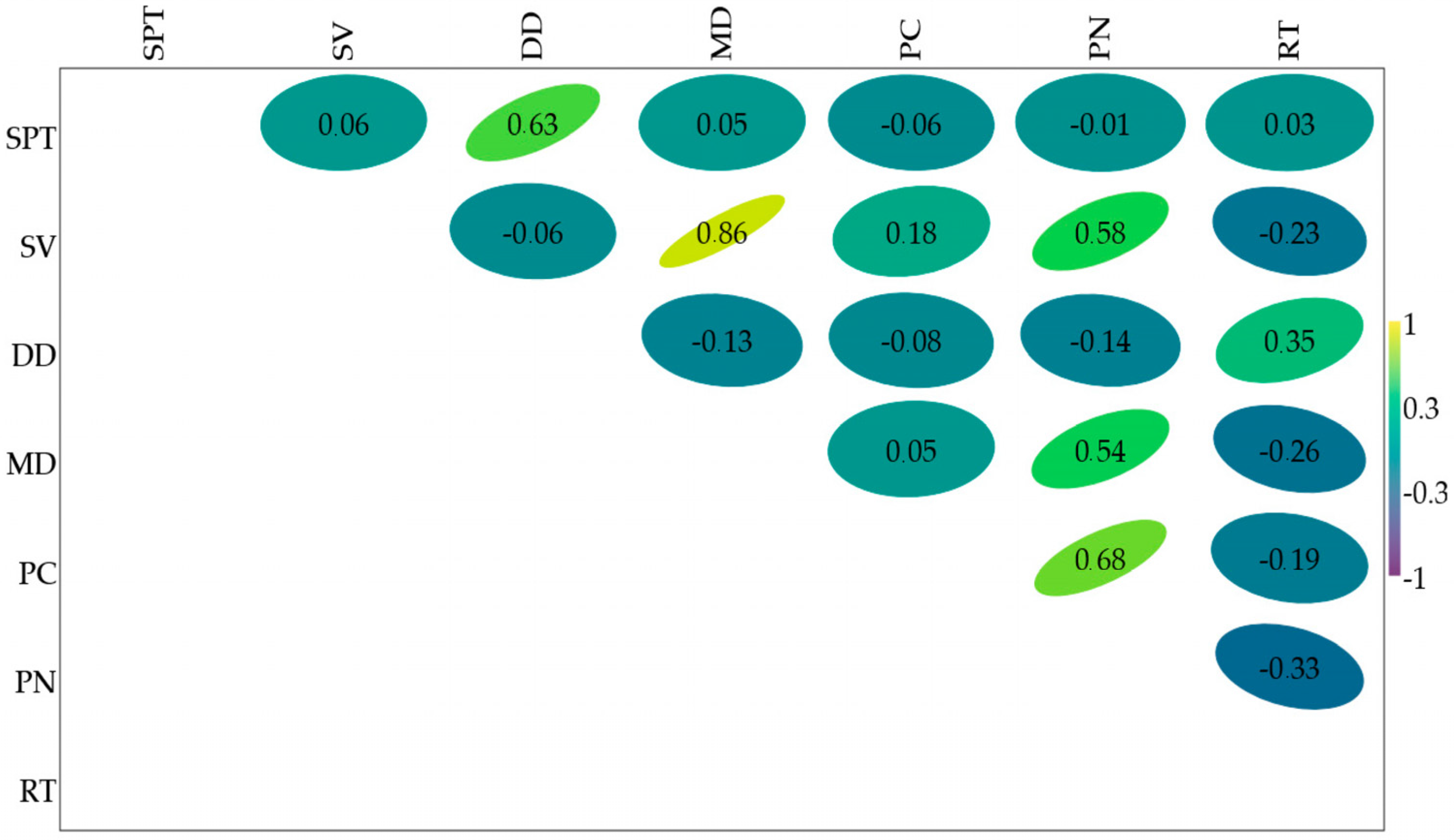
| Simulation 1 | Simulation 2 | ||
|---|---|---|---|
| Inner diameter | m | 0.78 | 0.78 |
| H inclusion | m | 1.29 | 0.98 |
| Depth | m | 1.8 | 1.8 |
| H exclusion | m | 1.6 | 1.6 |
| H emergence | m | 1.24 | 0.90 |
| Volume of one pumping | dm3 | 148.05 | 296.11 |
| Number of Pumps in a System | 20 | 30 | 40 | 50 | 75 | 100 |
|---|---|---|---|---|---|---|
| dm3 | ||||||
| SIM 00 | 499 | 477 | 463 | 462 | 458 | 468 |
| SIM LINK | 752 | 719 | 695 | 680 | 692 | 705 |
| Simulation: DOUBLE | |||||
|---|---|---|---|---|---|
| Number of Pumps in the System | Theoretical Time | SIM1 | SIM2 | SIM1 | SIM2 |
| Time extension | |||||
| s | % | ||||
| 20 | 179,711 | 191,612 | 190,151 | 6.2 | 5.5 |
| 30 | 243,843 | 267,183 | 264,139 | 8.7 | 7.7 |
| 40 | 306,567 | 340,846 | 339,513 | 10.1 | 9.7 |
| 50 | 374,199 | 425,117 | 422,075 | 12 | 11.3 |
| 75 | 561,521 | 673,872 | 683,197 | 16.7 | 17.8 |
| 100 | 800,357 | 981,394 | 989,314 | 18.4 | 19.1 |
| Simulation: 00 | |||||
| 20 | 113,840 | 124,020 | 122,580 | 8.2 | 7.1 |
| 30 | 163,232 | 169,380 | 173,520 | 3.6 | 5.9 |
| 40 | 211,255 | 220,200 | 221,520 | 4.1 | 4.6 |
| 50 | 263,498 | 278,640 | 282,060 | 5.4 | 6.6 |
| 75 | 391,825 | 424,560 | 425,640 | 7.7 | 7.9 |
| 100 | 533,840 | 625,980 | 623,940 | 14.7 | 14.4 |
| Time Interval | |||||||
|---|---|---|---|---|---|---|---|
| % | Number of Incidents | % | Number of Incidents | % | Number of Incidents | % | s |
| SIM2_75_00 | SIM1_75_00 | SIM2_75_LINK | SIM1_75_LINK | ||||
| 1.7 | 2 | 1.3 | 3 | 0.6 | 2 | 1.5 | 5–6 |
| 7.4 | 9 | 6.6 | 15 | 7.3 | 23 | 5.4 | 6–7 |
| 10.7 | 13 | 5.7 | 13 | 6.7 | 21 | 11.7 | 7–8 |
| 5.8 | 7 | 3.5 | 8 | 4.1 | 13 | 3.7 | 8–9 |
| 2.5 | 3 | 2.6 | 6 | 1.3 | 4 | 2 | 9–10 |
| 2.5 | 3 | 1.8 | 4 | 1.3 | 4 | 0.5 | 10–11 |
| 2.5 | 3 | 2.6 | 6 | 1.3 | 4 | 0.5 | 11–12 |
| 0.8 | 1 | 2.2 | 5 | 3.5 | 11 | 1.5 | 12–13 |
| 2.5 | 3 | 1.3 | 3 | 2.9 | 9 | 1 | 13–14 |
| 2.5 | 3 | 0.4 | 1 | 2.2 | 7 | 2.2 | 14–15 |
| 1.7 | 2 | 3.1 | 7 | 2.5 | 8 | 1.2 | 15–16 |
| 0.8 | 1 | 3.5 | 8 | 5.4 | 17 | 4.9 | 16–17 |
| 5.8 | 7 | 4.4 | 10 | 3.8 | 12 | 6.3 | 17–18 |
| 19.8 | 24 | 17.1 | 39 | 16.2 | 51 | 16.8 | 18–19 |
| 21.5 | 26 | 21.1 | 48 | 17.5 | 55 | 13.4 | 19–20 |
| 7.4 | 9 | 6.1 | 14 | 11.1 | 35 | 12.4 | 20–21 |
| 2.5 | 3 | 10.1 | 23 | 7.6 | 24 | 9.3 | 21–22 |
| 1.7 | 2 | 6.6 | 15 | 4.8 | 15 | 5.9 | 22–23 |
| 100 | 121 | 100 | 228 | 100 | 315 | 100 | Total |
| 0.54 | 0.63 | 0.69 | 0.72 | Correlation coefficient | |||
Disclaimer/Publisher’s Note: The statements, opinions and data contained in all publications are solely those of the individual author(s) and contributor(s) and not of MDPI and/or the editor(s). MDPI and/or the editor(s) disclaim responsibility for any injury to people or property resulting from any ideas, methods, instructions or products referred to in the content. |
© 2023 by the authors. Licensee MDPI, Basel, Switzerland. This article is an open access article distributed under the terms and conditions of the Creative Commons Attribution (CC BY) license (https://creativecommons.org/licenses/by/4.0/).
Share and Cite
Sionkowski, T.; Halecki, W.; Chmielowski, K. An Evaluation of Pumping Stations for Pressure Sewers System Made from Concrete Coils, Polymer Concrete, and High-Density Polyethylene (HDPE). Materials 2023, 16, 524. https://doi.org/10.3390/ma16020524
Sionkowski T, Halecki W, Chmielowski K. An Evaluation of Pumping Stations for Pressure Sewers System Made from Concrete Coils, Polymer Concrete, and High-Density Polyethylene (HDPE). Materials. 2023; 16(2):524. https://doi.org/10.3390/ma16020524
Chicago/Turabian StyleSionkowski, Tomasz, Wiktor Halecki, and Krzysztof Chmielowski. 2023. "An Evaluation of Pumping Stations for Pressure Sewers System Made from Concrete Coils, Polymer Concrete, and High-Density Polyethylene (HDPE)" Materials 16, no. 2: 524. https://doi.org/10.3390/ma16020524
APA StyleSionkowski, T., Halecki, W., & Chmielowski, K. (2023). An Evaluation of Pumping Stations for Pressure Sewers System Made from Concrete Coils, Polymer Concrete, and High-Density Polyethylene (HDPE). Materials, 16(2), 524. https://doi.org/10.3390/ma16020524







